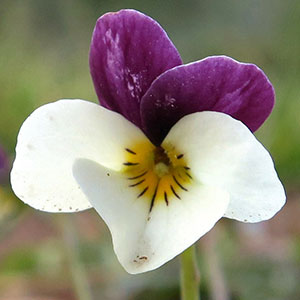Viola hallii
Viola tomentosa
Hall's violet, Oregon violet, wild pansy
felt-leaf violet, woolly or felt-leaf or feltleaf violet, woolly violet
1–3, decumbent or ascending to erect, ca. 1/2 subterranean, glabrous, clustered on single, short, vertical, deep-seated caudex.
1–3(–5), prostrate or decumbent to erect, leafy proximally and distally, densely white-tomentose, from usually vertical, subligneous rhizome.
basal and cauline;
basal: 1–4, palmately compound, ± 2-ternate or 3-ternate, leaflets 3;
stipules adnate to petiole, forming 2 linear-lanceolate wings, unlobed, margins entire, apex of each wing free, acute;
petiole 5–8 cm, glabrous;
blade ovate to deltate, 2.8–6 × 2.6–6.5 cm, ± coriaceous, base tapered, ultimate lobes narrowly elliptic, lanceolate, or oblanceolate, 1–7 mm wide, margins entire, ciliate or eciliate, apex acute, mucronulate, surfaces glabrous;
cauline similar to basal except: stipules usually lanceolate, sometimes broadly ovate, ± leaflike, margins toothed;
petiole 1.3–6 cm;
blade 2–4.8 × 1.2–5.5 cm.
basal and cauline;
basal: 1–6;
stipules linear to broadly ovate-oblong, margins entire, sometimes with scattered glandular hairs, apex acute to obtuse;
petiole 2–6 cm, densely white-tomentose;
blade ± oblanceolate to elliptic, 1.5–5 × 1.4–2.1 cm, base attenuate, usually oblique, margins usually entire, rarely crenate distally, ciliate, apex acute to usually obtuse, mucronulate, surfaces densely white-tomentose abaxially, strigose adaxially;
cauline similar to basal except: stipules ovate, lanceolate, oblanceolate, or oblong, margins entire or toothed, densely ciliate with white hairs;
petiole 1.5–3.5 cm;
blade 1.8–4 × 0.6–1.1 cm.
2.5–11 cm, glabrous.
1–4 cm, densely white-tomentose.
sepals lanceolate to ovate, margins ciliate, auricles 0.5–1 mm;
petals: upper 2 almost black abaxially, dark reddish violet adaxially, lower 3 pale yellow, cream, or ± white, lateral 2 bearded, with deep yellow to orange patch basally, dark reddish violet-veined, lowest with deep yellow to orange patch basally, dark reddish violet-veined, 5–18 mm, spur yellow, gibbous, 0.5–2 mm;
style head bearded; cleistogamous flowers absent.
sepals lanceolate, margins ciliate-tomentose, auricles 0.5–1 mm;
petals deep lemon-yellow adaxially, upper 2 often brownish purple abaxially, lower 3 dark brown- to brownish purple-veined, lateral 2 bearded, lowest 6–11 mm, spur yellow, gibbous, 0.5–1.5 mm;
style head bearded; cleistogamous flowers absent.
ellipsoid, 4–12 mm, glabrous.
± spherical, 4–5 mm, densely white-tomentose.
light brown, shiny, 3.2–3.5 mm.
brown with lighter brown mottling, 2.5–2.8 mm.
= 60, 72.
= 12.
Viola hallii
Viola tomentosa
Viola hallii was discovered on the grounds of Willamette University in Salem, Oregon, by Elihu Hall, a professor at that institution (V. B. Baird 1942). Leaves of V. hallii are similar to V. beckwithii.
(Discussion copyrighted by Flora of North America; reprinted with permission.)
Viola tomentosa occurs in El Dorado, Nevada, Placer, Plumas, and Sierra counties. M. S. Baker (1949) reported that nearly every leaf axil of V. tomentosa produces a flower bud and that these buds produce chasmogamous flowers late in season instead of cleistogamous flowers, as do other members of the V. nuttallii complex.
Viola tomentosa hybridizes with V. purpurea; the hybrids appeared sterile (M. S. Baker 1949). J. Clausen (1964) reported a putative hybrid between V. tomentosa and V. sheltonii from one location in Sierra County.
(Discussion copyrighted by Flora of North America; reprinted with permission.)


